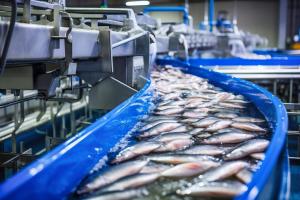Seafood Processing Equipment Market Size to Worth USD 3.81 Billion by 2032 | CAGR of 5.4% during 2024-2032
Key companies in the seafood processing equipment market are JBT Corporation, Carsoe Group A/S, BAADER Group (Germany), CTB Inc (U.S.), & Others
The global seafood processing equipment market reached a valuation of USD 3.81 billion in 2032, reflecting the installation of over 15,000 new units worldwide. Annual unit shipments surpassed 4,800 systems, with processing capacity exceeding 3 million tonnes of seafood annually. In 2023, automated filleting lines accounted for 28 percent of total equipment deployment, while packaging systems comprised 22 percent of installations. Asia Pacific dominated the global market with a share of 34.71% in 2023.
Get a Free Sample Research PDF: https://www.fortunebusinessinsights.com/enquiry/sample/110784
Key Findings for this Report
Top Driver Reason: Expansion of cold-chain infrastructure boosting demand for advanced smoke and drying equipment.
Top Country/Region: China led installations with 850 new units in 2023, representing 18 percent of global capacity additions.
Top Segment: Filleting equipment held 28 percent share of global unit shipments, the largest among all categories.
List of Top Seafood Processing Equipment Market Companies
• JBT Corporation (U.S.)
• Carsoe Group A/S (Denmark)
• BAADER Group (Germany)
• CTB Inc (U.S.)
• Coastline Equipment Inc (U.S.)
• Marel (Iceland)
• Bettcher Industries Inc (U.S.)
• Buhler Group (Switzerland)
Top Two Companies with Highest Share
• JBT Corporation (U.S.) – Held 14 percent share of global unit shipments in 2023, deploying 680 systems.
• Marel (Iceland) – Accounted for 12 percent share with 580 new units installed worldwide.
Seafood Processing Equipment Market Trends
In 2024, adoption of robotics in filleting operations surged by 35 percent in Europe, with 420 robotic filleting cells installed. Packaging automation grew by 30 percent year on year, totaling 1 050 packaging lines globally. Demand for combined smoke drying units rose by 22 percent, reaching 520 installations. Over 70 percent of new gut and scale machines featured stainless steel hygienic design compliant with 3A standards.
Seafood Processing Equipment Market Dynamics
Annual global production of processed seafood exceeded 90 million tonnes in 2023, necessitating equipment upgrades across 5 000 facilities. Installed base of smoke and drying equipment surpassed 3 400 units, with Asia-Pacific accounting for 1 200 of these. Over 800 manual filleting stations remain operational in small scale plants, while semi automatic systems numbered 2 300 globally.
Drivers of Market Growth:
In 2023, 1 450 cold storage warehouses were commissioned in coastal regions, increasing demand for smoke and drying equipment by 18 percent. Over 1 100 new IQF (individually quick frozen) tunnels were installed, representing 26 percent of all new equipment orders. Investments in refrigerated transport fleets grew by 12 percent, driving requirement for inline packaging machines. Cold-chain investments in North America amounted to USD 1.2 billion in equipment procurement alone, supporting deployment of 380 gut and scale systems. Asia-Pacific cold-storage capacity expanded by 2.8 million m³, boosting demand for filleting and cutting equipment by 22 percent.
Market Restraints:
In 2023, average cost of an automatic filleting line was USD 1.5 million per unit, deterring 35 percent of small scale processors. Over 400 planned installations were deferred due to budget constraints, representing 8 percent of total project pipelines. Leasing options covered only 15 percent of equipment value on average, leaving 85 percent financed through CAPEX. Small processors (<5 tonne/day capacity) postponed acquisitions of robotics enabled skinning machines, which carry price tags of USD 250 000 each. As a result, 300 manual stations remained in service beyond their intended 10 year lifespan, increasing maintenance costs by 22 percent.
Market Opportunities:
By the end of 2023, 520 processing lines incorporated cloud based monitoring, representing 11 percent of the installed base. Predictive analytics platforms were adopted on 340 packaging lines, reducing unplanned downtime by 28 percent. Over 270 processors subscribed to remote diagnostics services, enabling 24/7 monitoring of vibration and temperature parameters. Investments in IIoT sensors rose by 45 percent, with 1 100 new sensor kits deployed. Service contracts for predictive maintenance reached USD 75 million in total, covering 1 250 units. These digital upgrades offer potential to reduce energy consumption by up to 12 percent per line.
Market Challenges:
In 2023, 72 percent of new equipment had to meet enhanced CIP (clean in place) requirements, increasing machine downtime by 8 percent on average. Over 1 800 units underwent retrofitting to comply with revised EU Regulation 2021/382 on processing hygiene. Certification processes delayed 210 installations by an average of 45 days. Processors in North America faced FSMA Section 117 audits, resulting in 95 percent of facilities upgrading equipment surfaces to mirror finishes (Ra < 0.8 μm). Asia-Pacific regulators issued 1 350 non compliance notices, driving replacement of 420 manual filleting stations.
Connect with Our Expert for any Queries: https://www.fortunebusinessinsights.com/enquiry/speak-to-analyst/110784
Seafood Processing Equipment Market Segmentation
The market is segmented by equipment type, operation mode, and seafood type. Gut and scale equipment accounted for 18 percent of 2023 unit shipments, filleting equipment 28 percent, cutting equipment 16 percent, skinning equipment 12 percent, smoke and drying equipment 11 percent, packaging equipment 22 percent, and grinders/specialized cleaning 5 percent. Automatic systems comprised 54 percent of new orders (2 600 units), while manual and semi automatic combined for 46 percent (2 200 units). By seafood type, fish processing equipment represented 62 percent of total shipments, crustaceans 18 percent, mollusks 10 percent, cephalopods 6 percent, and others (seaweed, kelp) 4 percent.
Seafood Processing Equipment Market Regional Outlook
North America installed 1 300 new units in 2023, accounting for 27 percent of global shipments, with 560 packaging lines and 340 filleting systems.
Europe added 1 200 units (25 percent share), including 420 skinning machines and 300 smoke drying units.
Asia Pacific led with 1 900 units (40 percent share), featuring 850 filleting lines and 520 gut and scale systems.
Middle East & Africa recorded 400 installations (8 percent), focusing on 180 packaging lines and 90 cutting systems.
Latin America contributed 250 units (5 percent), primarily in packaging and filleting segments.
Recent Development
JBT launched a robotic filleting cell achieving 1 500 cuts per hour.
Our Other Research Reports
Food Processing and Handling Equipment Market Growth rate, Size Share Report
Food Processing Equipment Market Growth rate, Size Share Report
Ashwin Arora
Fortune Business Insights™ Pvt. Ltd.
+1 833-909-2966
sales@fortunebusinessinsights.com
Visit us on social media:
Facebook
X
LinkedIn
Legal Disclaimer:
EIN Presswire provides this news content "as is" without warranty of any kind. We do not accept any responsibility or liability for the accuracy, content, images, videos, licenses, completeness, legality, or reliability of the information contained in this article. If you have any complaints or copyright issues related to this article, kindly contact the author above.
SGS Launches First AI-Powered Thermal Runaway Testing Solution for Energy Storage Batteries
Top Orthopedic Power Tool Supplier Shines At The 91st China International Medical Equipment Fair (CMEF 2025)
What Passage Indexing Means for Websites: Insights from Actual SEO Media, Inc.
Więcej ważnych informacji
 Jedynka Newserii
Jedynka Newserii

 Jedynka Newserii
Jedynka Newserii

Polityka

D. Joński: Nie wiemy, co zrobi Rosja za dwa–trzy lata. Według duńskiego wywiadu może zaatakować kraje nadbałtyckie i musimy być na to gotowi
Zdecydowana większość krajów unijnych wskazuje na potrzebę wzmocnienia zdolności obronnych Europy w obliczu coraz bardziej złożonego geopolitycznego tła. Wywiady zachodnich państw wskazują, że Rosja może rozpocząć konfrontację z NATO jeszcze przed 2030 rokiem. Biała księga w sprawie obronności europejskiej „Gotowość 2030” zakłada m.in. ochronę granic lądowych, powietrznych i morskich UE, a sztandarowym projektem ma być Tarcza Wschód. – W budzeniu Europy duże zasługi ma polska prezydencja – ocenia europoseł Dariusz Joński.
Transport
Duże magazyny energii przyspieszą rozwój transportu niskoemisyjnego w Europie. Przyszłością może być wodór służący jako paliwo i nośnik energii

Zmiany w europejskim transporcie przyspieszają. Trendem jest elektromobilność, zwłaszcza w ramach logistyki „ostatniej mili”. Jednocześnie jednak udział samochodów w pełni elektrycznych w polskich firmach spadł z 18 do 12 proc., co wpisuje się w szerszy europejski trend spowolnienia elektromobilności. Główne bariery to ograniczona liczba publicznych stacji ładowania, wysoka cena pojazdów i brak dostępu do odpowiedniej infrastruktury. – Potrzebne są odpowiednio duże magazyny taniej energii. Przyszłością przede wszystkim jest wodór – ocenia Andrzej Gemra z Renault Group.
Infrastruktura
W Polsce w obiektach zabytkowych wciąż brakuje nowoczesnych rozwiązań przeciwpożarowych. Potrzebna jest większa elastyczność w stosowaniu przepisów

Pogodzenie interesów konserwatorów, projektantów, inwestorów, rzeczoznawców i służby ochrony pożarowej stanowi jedno z największych wyzwań w zakresie ochrony przeciwpożarowej obiektów konserwatorskich. Pożary zabytków takich jak m.in. katedra Notre-Dame w Paryżu przyczyniają się do wprowadzania nowatorskich rozwiązań technicznych w zakresie ochrony przeciwpożarowej. W Polsce obowiązuje już konieczność instalacji systemów detekcji. Inwestorzy często jednak rezygnują z realizacji projektów dotyczących obiektów zabytkowych z uwagi na zmieniające się i coraz bardziej restrykcyjne przepisy czy też względy ekonomiczne.
Partner serwisu
Szkolenia

Akademia Newserii
Akademia Newserii to projekt, w ramach którego najlepsi polscy dziennikarze biznesowi, giełdowi oraz lifestylowi, a także szkoleniowcy z wieloletnim doświadczeniem dzielą się swoją wiedzą nt. pracy z mediami.




![Nestlé w Polsce podsumowuje wpływ na krajową gospodarkę. Firma wygenerowała 0,6 proc. polskiego PKB [DEPESZA]](https://www.newseria.pl/files/1097841585/fabryka-nesquik_1,w_85,r_png,_small.png)




.gif)

 |
| |
| |
|